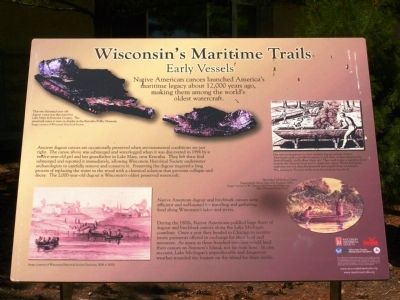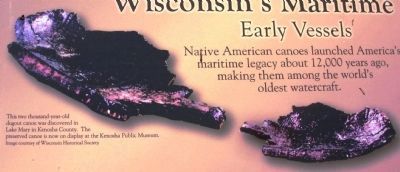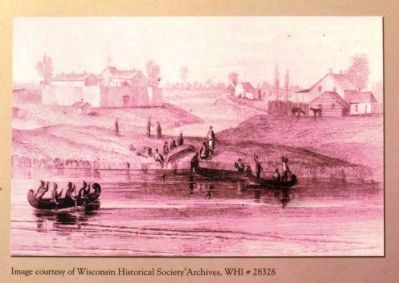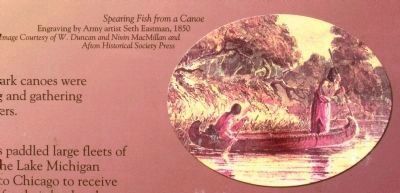Kenosha in Kenosha County, Wisconsin — The American Midwest (Great Lakes)
Early Vessels
Wisconsin's Maritime Trails
Ancient dugout canoes are occasionally preserved when environmental conditions are just right. The canoe above was submerged and waterlogged when it was discovered in 1996 by a twelve-year-old girl and her grandfather in Lake Mary, near Kenosha. They left their find submerged and reported it immediately, allowing Wisconsin Historical Society underwater archaeologists to carefully remove and conserve it. Preserving the dugout required a long process of replacing the water in the wood with a chemical solution that prevents collapse and decay. The 2,000 year old dugout is Wisconsin's oldest known watercraft.
Native American dugout and birchbark canoes were efficient and well-suited for traveling and gathering food along Wisconsin's lakes and rivers.
During the 1800s, Native Americans paddled large fleets of dugout and birchbark canoes along the Lake Michigan coastline. Once a year they headed to Chicago to receive treaty payments offered in exchange for their land and resources. As many as three hundred travelers would land their canoes on Simmon's Island, not far from here. In one account, Lake Michigan's unpredictable and dangerous weather stranded the boaters on the island for three weeks.
Erected by Wisconsin Historical Society and University of Wisconsin Sea Grant Institute.
Topics and series. This historical marker is listed in these topic lists: Exploration • Native Americans • Settlements & Settlers • Waterways & Vessels. In addition, it is included in the Wisconsin’s Maritime Trails series list. A significant historical year for this entry is 1996.
Location. 42° 35.181′ N, 87° 48.773′ W. Marker is in Kenosha, Wisconsin, in Kenosha County. Marker is at the intersection of First Avenue and 56th Street, on the right when traveling south on First Avenue. Marker is located in front of Kenosha Public Museum. Touch for map. Marker is at or near this postal address: 5500 First Avenue, Kenosha WI 53140, United States of America. Touch for directions.
Other nearby markers. At least 8 other markers are within walking distance of this marker. Kee-neau-sha-Kau-ning (within shouting distance of this marker); Kenosha (Southport) Lighthouse (approx. 0.3 miles away); Southport-Kenosha (approx. 0.3 miles away); Naval Memorial (approx. 0.3 miles away); The United States Marine Corps (approx. 0.3 miles away); Simmon's Island Beach House (approx. 0.3 miles away); Simmons Island Park (approx. 0.3 miles away); Remember Pearl Harbor (approx. 0.3 miles away). Touch for a list and map of all markers in Kenosha.
Also see . . .
Wisconsin's Maritme Trails. Wisconsin Historical Society (Submitted on July 26, 2012, by Bernard Fisher of Richmond, Virginia.)
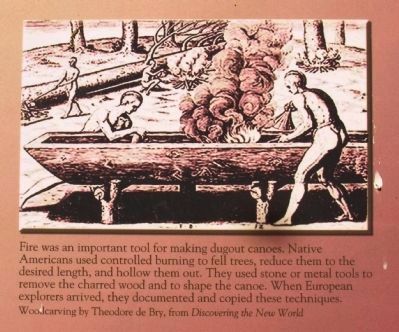
Photographed By Paul Fehrenbach, June 25, 2012
5. Photo upper right
Fire was an important tool for making dugout canoes. Native Americans used controlled burning to fell trees, reduce them to the desired length, and hollow them out. They used stone or metal tools to remove the charred wood and to shape the canoe. When European explorers arrived, they documented and copied the techniques. Woodcarving by Theodore de Bry, from Discovering the New World
Credits. This page was last revised on June 16, 2016. It was originally submitted on July 25, 2012, by Paul Fehrenbach of Germantown, Wisconsin. This page has been viewed 610 times since then and 11 times this year. Photos: 1, 2, 3, 4, 5, 6. submitted on July 25, 2012, by Paul Fehrenbach of Germantown, Wisconsin. • Bernard Fisher was the editor who published this page.
